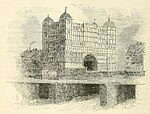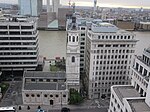Chapel of St Thomas on the Bridge
Buildings and structures demolished in 1832Churches completed in 1209Churches in the City of LondonFormer buildings and structures in the City of LondonInfobox religious building with unknown affiliation

The Chapel of St Thomas on the Bridge was a bridge chapel built near the centre of "Old" London Bridge in the City of London and was completed by 1209. In 1548, during the Reformation, it was dissolved as a place of worship and soon afterwards converted to secular use. The building survived as a dwelling and warehouse until 1747 when the upper storey at street level was removed; the lower storey, which was built into the structure of one of the piers, remained in use as a store until Old London Bridge was demolished in 1832.
Excerpt from the Wikipedia article Chapel of St Thomas on the Bridge (License: CC BY-SA 3.0, Authors, Images).Chapel of St Thomas on the Bridge
Grant's Quay Wharf, City of London
Geographical coordinates (GPS) Address Website Nearby Places Show on map
Geographical coordinates (GPS)
| Latitude | Longitude |
|---|---|
| N 51.508238888889 ° | E -0.086780555555556 ° |
Address
Berwin Leighton Paisner
Grant's Quay Wharf
EC3R 6HD City of London
England, United Kingdom
Open on Google Maps










